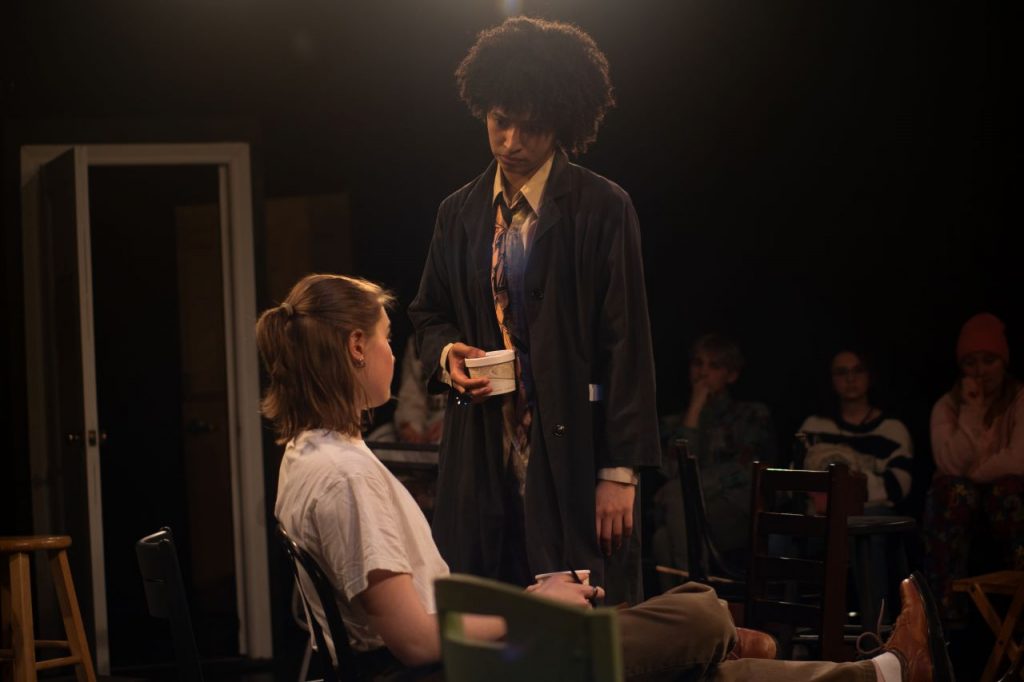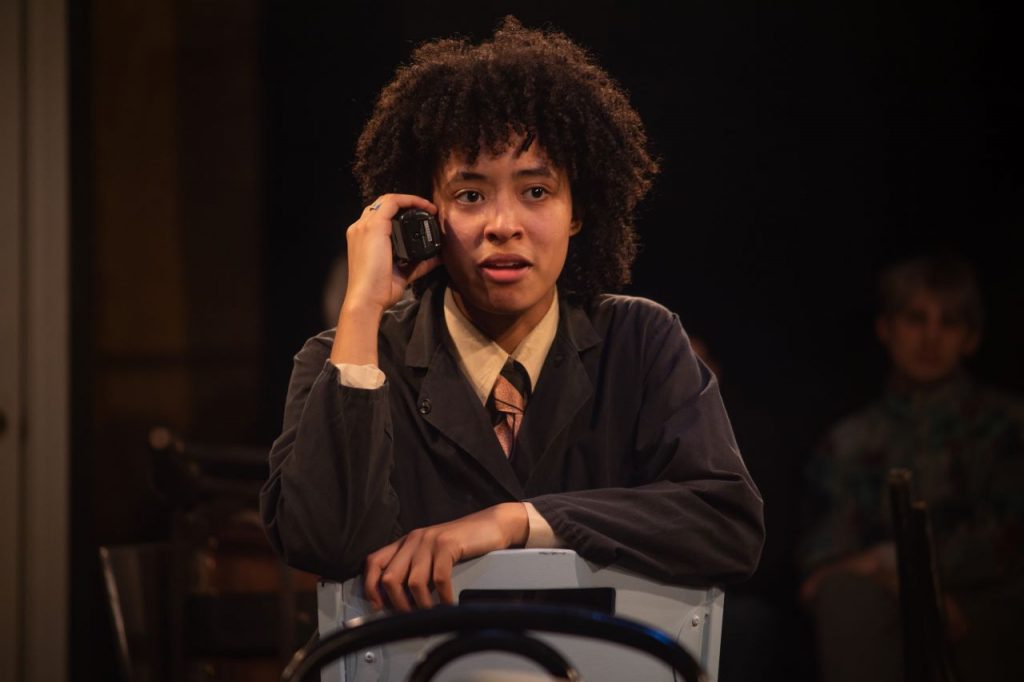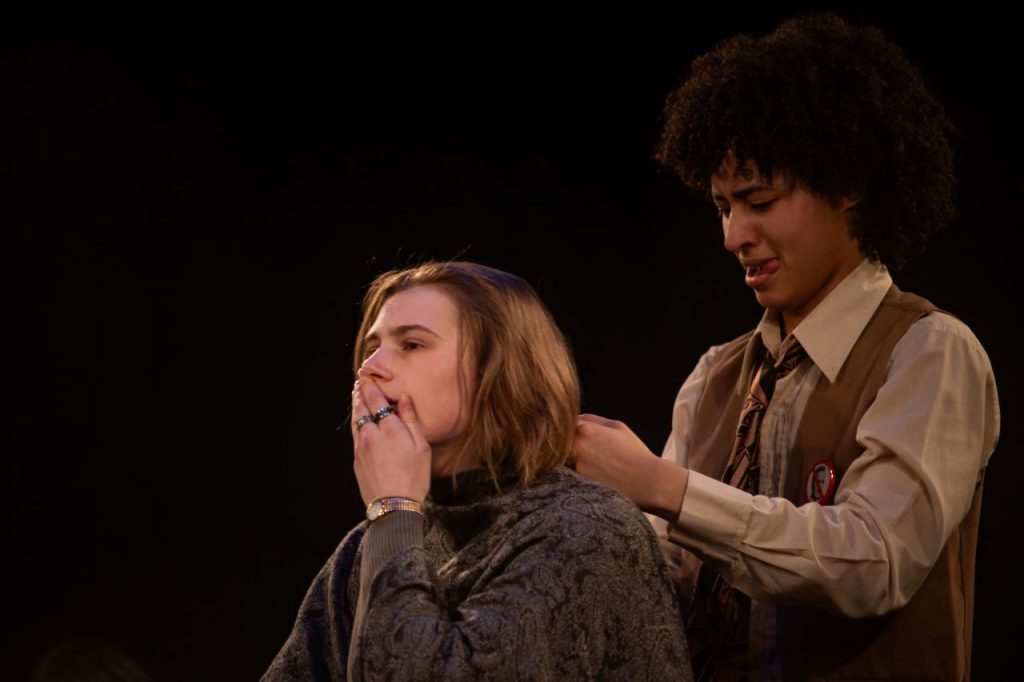BY BEL KIELY ’24

On a rainy March night, I attended the opening of Austin Brannan’s ’24 studio lab production of Lonely Planet by Steven Dietz. With a simple pull of the nearest black curtain, Brannan effortlessly transformed Studio A into a narrow, dimly lit hallway, which I followed to the only entrance: an open doorway to Jody’s Maps, where the entire play unfolds.
Stepping over the threshold, I was immediately immersed in the colorful and intimate world of the map store, a circular room adorned with cozy furniture. Large maps of the world hung from the ceiling, and small ones were scattered throughout the store; furled into tight rolls, they peeked out of bins or casually leaned against Jody’s desk and on the small shelf in the corner where a glass water cooler and lamp sat. A silver clock gleamed on the side table next to a standing globe. The attention to detail in Brannan and Lillie Shelor’s ’25 set design of Lonely Planet dropped me right into the world of the play–a testament to Brannan’s dramaturgical portfolio they completed last semester, which involved extensive research into the political scope of the 1980s-90s AIDS epidemic and the various cultural and literary references Dietz makes in the play.
Set on the oldest street of an unnamed American city in 1993, Dietz’s Lonely Planet follows the friendship of two gay men: the introverted, book-smart Jody and his energetic, eccentric friend Carl, who seems to live multiple lives, claiming to work more part-time jobs than one person could ever possibly manage. The play opens with a single chair standing in a pool of light. A surprised and curious Jody, played by Ken Caron-Quinn ’27, discovers the chair and sits in it, wondering aloud where it came from. After a brief moment, the door flings open, and Carl, played by Sydney Mann ’27, bounds into the room, announcing that “Everyone is boring,” to which Jody, ignoring this outburst, asks Carl where the mysterious chair came from (Dietz 9). Although a mismatched pair, the two fall into an easy routine: Jody tells Carl about his most recent dream while Carl tells Jody about what he does for a living; depending on the day, his job varies from watering plants for corporations, restoring art at a museum, running an auto glass shop, writing for a “disreputable tabloid,” or working as a bartender (Dietz 15). The central conflict arises when Carl brings more and more chairs into the store despite Jody’s complaint that they are “horribly, disastrously IN THE WAY” (Dietz 19). The play’s mood darkens when we realize the chairs belong to Carl and Jody’s friends, who have died from an unnamed disease. Although the virus is never specified–as if uttering its name is too threatening, too painful of a reminder of its violent presence in these characters’ lives–it is clear that the disease is a reference to the HIV/AIDS epidemic that would peak in two years in 1995.

We watch as Jody and Carl find different ways to cope with the virus that lingers outside the door. For Jody, it manifests by sheltering in the map store, using the building itself and the chairs that continue to crowd the room as a physical barrier between him and the disease that has affected so many people he knows. For Carl, constant motion and endless distractions seem the only way to cope. The map store transforms into a way station that receives calls, and Carl, the messenger, answers the calls and runs out into the world to collect another chair to bring back to the store. As the play progresses, the room steadily becomes cluttered with chairs of all different sizes, styles, and stories. Their presence in the store eventually rubs off on Jody. Convinced by Carl to get out more, perhaps through his incessant nagging or the presence of the chairs themselves, Jody leaves the store to get tested and learns he is negative. However, the play takes a surprising and devastating turn when, in Act 2, Scene 3, Jody says, “One night, a few months later, I saw a chair here.” In the following scene, depicting a liminal space between here and the afterlife, the two men crouch amongst the stacks of chairs and speak to each other on the phone for the rest of the scene. We realize that the chair Jody sees is Carl’s only chair, “a 1950s silver kitchen chair, with a turquoise seat” (Dietz 51). Brannan’s play ended in a beautiful stage picture that pulled at my heartstrings: Carl, lost to AIDS, sitting amongst the heap of chairs while Jody opens the front door to the shop and steps out into the world.
Austin Brannan’s Lonely Planet was a thoughtful and heartfelt exploration of queer friendship amid the uncertainty and heavy grief of the HIV/AIDs epidemic. Dietz’s story was impressively brought to life by Caron-Quinn and Mann. I was struck by how the actors showed up in the space with sharp focus and presence, demanding the audience’s full attention. Caron-Quinn and Mann remained open and listened to each other throughout, delighting the audience with their simple, daily activities. They talk about Ionseco’s play The Chairs over a haircut, share a simple meal of bread and soup, play a game where they “tell the truth,” and confess their anxieties, fears, and insecurities. And, of course, Jody recounts his dreams, in which he always remembers halfway through that Carl was there. The effectiveness and precision of Brannan’s directing style were evident in Caron-Quinn and Mann’s ability to maintain a balance between light-hearted comedy and heart-wrenching, vulnerable moments. Despite their stark
personality differences, Jody and Carl form a deep bond, reflecting the need for genuine connection in unsettling and challenging times.

While not extravagant, the student-design elements embellished the “lonely planet” of Jody’s map store; ironically, while attempting to escape the world, Jody brings the world to him, through depictions of the earth, globes, maps, and objects from the outside. Sound designer Naomi Wagner ‘26 gave voice to the outside world that Jody hides from through the distant sound of cars driving by the store, heard periodically throughout the play. In moments of transition, a stream of fragmented, disjointed audio clips of news stories about the epidemic could be heard, effectively capturing the dizzying sensation of trying to keep up with the constant influx of news about the disease. Listening to the news clips in moody lighting brought into focus for me the bitter irony of the HIV/AIDS epidemic: despite being so personally devastating for Jody and Carl, it is then severely depersonalized and criticized in the media, dubbed “gay cancer” or the “gay plague.” The lighting, brilliantly executed by Maddie Evans ’24, helped illuminate key dramatic moments of tension in the piece and shifts in Jody and Carl’s friendship. In particular, when the lights dimmed, I noticed my attention shift to the Mercator Map, hung from the ceiling, which Jody references in his explanation of “The Greenland Problem.” This term refers to Greenland looking disproportionately big on conventional maps due to the German map maker Mercator, who distorted the “sizes and shapes of land masses” to allow for more straightforward navigation of sea routes (Dietz 21). Against a darker background, the map seemed to shine underneath a strong shaft of yellow light, emphasizing Jody’s testimony to maps: “They are fixed objects. They have been called ‘surrogates of space.’ They attempt to make order and reduce our reliance on hypotheses. They are a picture of what’s known” (Dietz 15). I was compelled by the connection Jody makes of the distortion of countries in mapping to the distortion of fact in our everyday lives: “We, too, have things on the periphery of our lives that we distort–to best focus on the things in front of us” (Dietz 21).
Whenever Carl re-entered the space with another story about his part-time job—”Well, things at the paper are crazy”—the lights would brighten again to reflect Carl’s uncontainable energy (Dietz 23). The costumes, designed by Sophie D’Amore ’26, were a compelling depiction of these two characters’ distinct personalities. Carl’s camouflage pants, a swirl of purple and gray, and vest with bright political pins emphasized his flamboyant personality and criticism of the current administration’s disregard for queer communities affected by the epidemic. Jody’s simple outfit of brown slacks and a gray cardigan reflected, by contrast, his more subdued, quiet nature. All these design aspects came together under the set design of Brannan and Shelor, which illustrated Dietz’s initial vision for this play, as referenced in Bannan’s dramaturgical portfolio as, imagining a man “who would surround himself with the world because he did not want to go out into it” (Brannan 28).

Ultimately, Lonely Planet was the kind of theater I found sticking to me–even days later. My ears had become attuned to the music of Dietz’s poetic language, made three-dimensional by Caron-Quinn and Mann. During the performance and afterward, I became aware that we were watching this play occur while sitting in chairs, gazing at the emptiness in the chairs before us. Brannan’s decision to stage the play in the round enacted the audience, giving us the active role of observing, of bearing witness to the chairs as a memorial to the people who have died from the HIV/AIDS epidemic. Sitting in a chair while looking at the emptiness in front of us made me turn inward, contemplating whether I associate furniture or other objects with people and how those objects reflect an aspect of their lives, a memory or story attached. The chairs felt embodied, heavy, in that space and reflected, as Carl says, quoting Ionesco: “We will leave behind traces, for we are people and not cities” (Dietz 52)
Sources:
Brannan, Austin, “Leaving Traces: Dramaturgy Packet,” Ed. 1, pp 2-32, 2023.
Dietz, Steven. Lonely Planet, Ed. 1, Dramatists Play Inc, 1983.
Photos by Coltrane Cho ’24
***
Bel Kiely ’24 is a staff writer for the Skidmore Theater Living Newsletter
